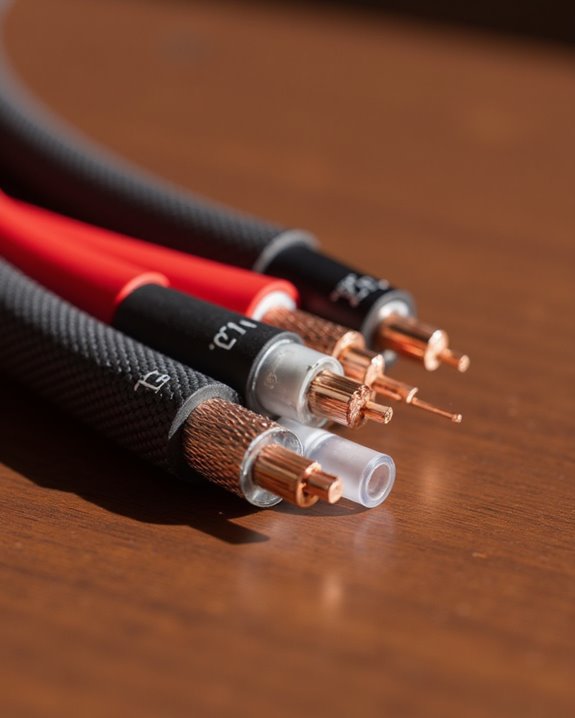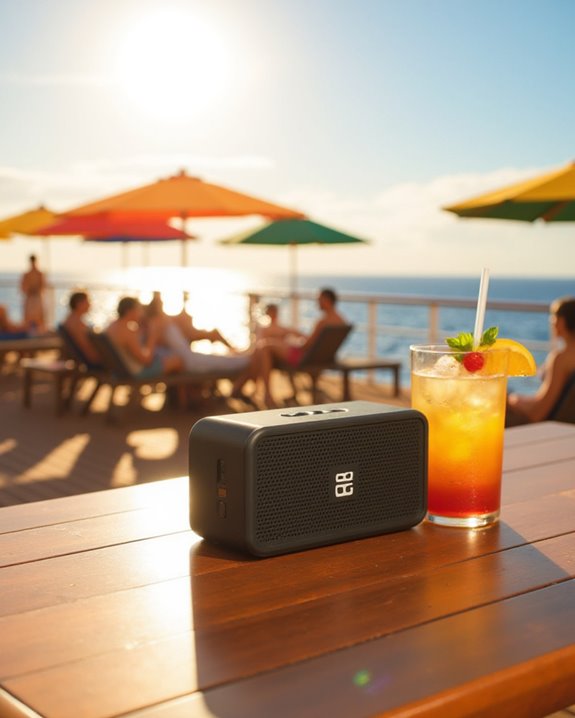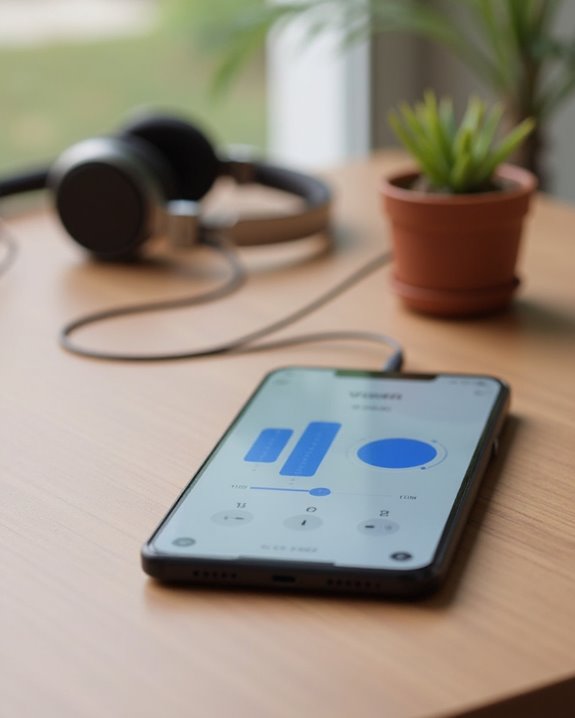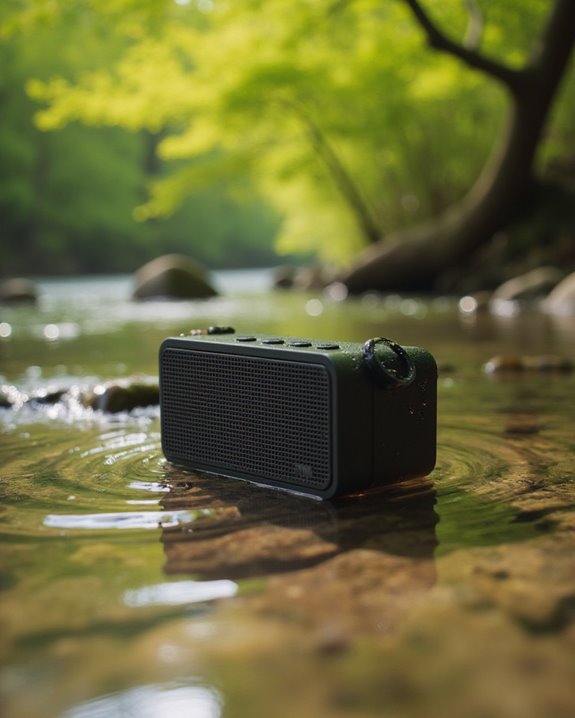Selecting the proper speaker wire gauge requires matching several key factors for best sound. Lower AWG numbers indicate thicker wires, with 16-gauge sufficient for 8-ohm speakers under 50 feet, 14-gauge for 50-100 feet, and 12-gauge for longer runs or high-power systems. Consider your speakers’ impedance (4-ohm needs thicker wire), amplifier power output, installation environment (in-wall requires UL-rated cables), and connection terminals. The following tips will reveal how these elements work together to maximize audio performance.
Key Takeaways
- Lower AWG numbers indicate thicker wire, with 16-gauge sufficient for 8-ohm speakers under 50 feet, 14-gauge for 50-100 feet.
- Impedance impacts gauge selection: 4-ohm speakers need thicker 12 AWG cables, while 8-ohm systems can use 16-18 AWG for shorter runs.
- Higher power amplifiers (100+ watts) require thicker cables, with 10 AWG recommended for 200+ watts and 8 AWG for 300+ watts.
- For in-wall installations, choose UL-rated CL2/CL3 wire to ensure compliance with fire safety codes.
- Consider environmental factors like moisture and UV exposure for outdoor installations, selecting cables with appropriate protection ratings.
10 Essential Tips for Choosing the Right Gauge Speaker Cable
When selecting speaker cables for a home audio system, understanding wire gauge specifications becomes essential for achieving ideal sound performance. The American Wire Gauge (AWG) system measures speaker wire thickness, with lower numbers indicating thicker wire that provides less resistance. For standard setups with 8-ohm speakers, 16-gauge wire performs adequately for distances up to 50 feet, balancing cost and signal integrity.
For longer runs, thicker wire becomes necessary to maintain audio quality. Experts recommend 14-gauge wire for distances between 50-100 feet, while 12-gauge offers superior performance for extended lengths or high-power applications. Speaker impedance also influences gauge selection, with lower impedance speakers (4-6 ohms) requiring thicker cables to handle increased current flow. Always calculate total wire length accurately, adding extra length for routing and connection flexibility when planning installations.
Understanding Speaker Wire Gauge Numbers and What They Mean
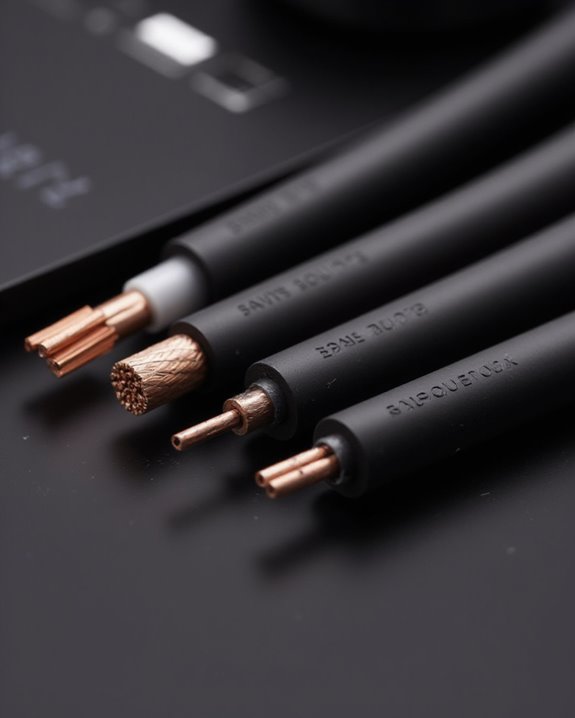
Speaker wire gauge numbers form the foundation of proper audio system design, representing a standardized measurement system that directly impacts sound quality and performance. The American Wire Gauge (AWG) system operates on an inverse scale, where lower numbers indicate thicker wire with less resistance. For example, 12 AWG speaker wire gauges are thicker and conduct signals more efficiently than 16 AWG wire.
When selecting the Right Speaker Wire Gauge, consumers should understand that for every three gauge numbers increase, wire thickness halves and resistance doubles. This relationship explains why thicker gauge speaker wire (10-12 AWG) performs better over longer distances, while thinner options (16-18 AWG) suffice for shorter runs under 50 feet. The right choice ultimately depends on balancing installation distance, power requirements, and budget considerations.
How Distance Affects Your Speaker Wire Gauge Selection
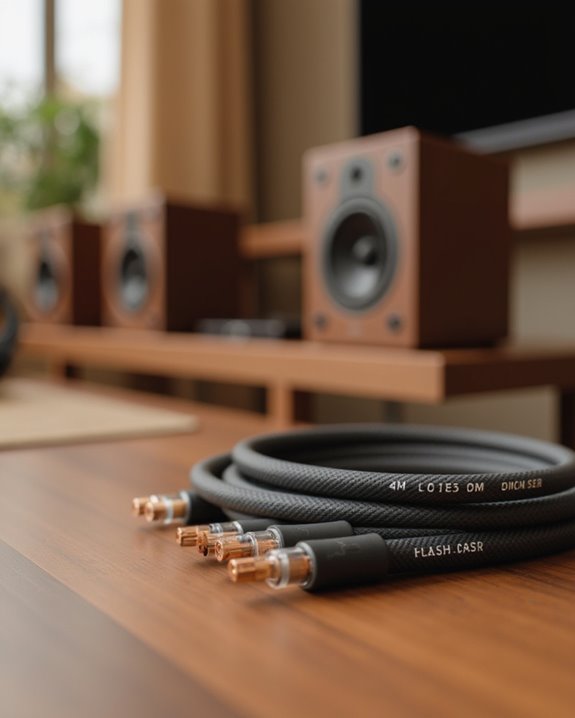
Why does the distance between your amplifier and speakers matter so greatly when selecting speaker wire? The answer lies in electrical resistance, which increases proportionally with wire length. For wire runs under 50 feet, 16 AWG speaker wires typically provide sufficient conductivity to minimize resistance and maintain sound quality. However, longer wires require thicker gauges to compensate for resistance buildup.
When distances exceed 50 feet, 14 AWG becomes the appropriate speaker wire choice, effectively preventing signal degradation in setups extending to 200 feet with eight-ohm speakers. For installations beyond 100 feet, particularly with four-ohm speakers, 12 AWG or thicker wire is essential. This selection principle follows a simple rule: every additional 50 feet of cable potentially doubles effective resistance in thinner gauges, making proper gauge selection critical for preserving audio fidelity in extended installations.
Matching Wire Gauge to Your Amplifier’s Power Output
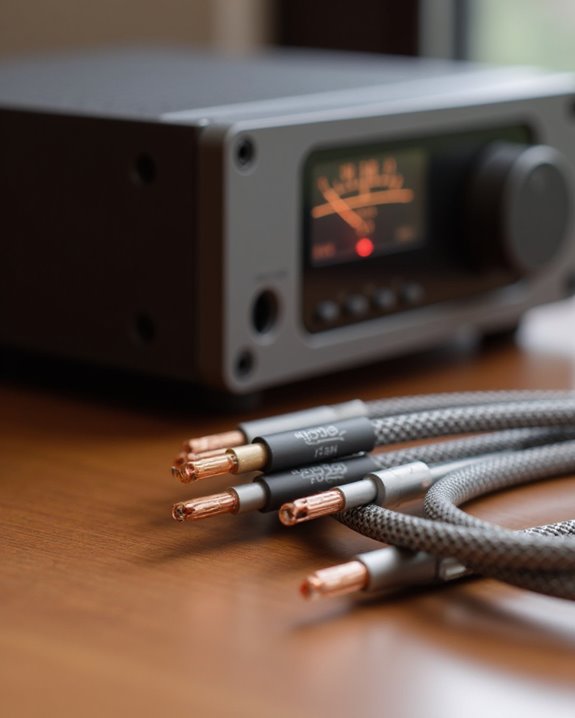
Distance between components is just one factor in proper speaker wire selection—amplifier power output represents another critical consideration that directly impacts cable gauge requirements. As power increases, so does the need for thicker speaker cables capable of handling higher current loads without overheating or experiencing voltage drop.
For systems with modest power ratings up to 50 watts per channel, 14 AWG wire typically suffices for runs under 50 feet. However, amplifiers delivering over 100 watts per channel demand 12 AWG or lower gauge wires to maintain signal integrity. High-current applications exceeding 200 watts benefit from 10 AWG cables, while extremely powerful amplifiers over 300 watts may require 8 AWG wires. Using thicker wires for powerful amplifiers minimizes resistance, which increases with smaller gauge options, ensuring efficient power transfer and preserving audio fidelity across the frequency spectrum.
When connecting 100-watt speakers, selecting the appropriate wire gauge is crucial to handle their high power outputs effectively.
Speaker Impedance and Its Impact on Wire Gauge Requirements
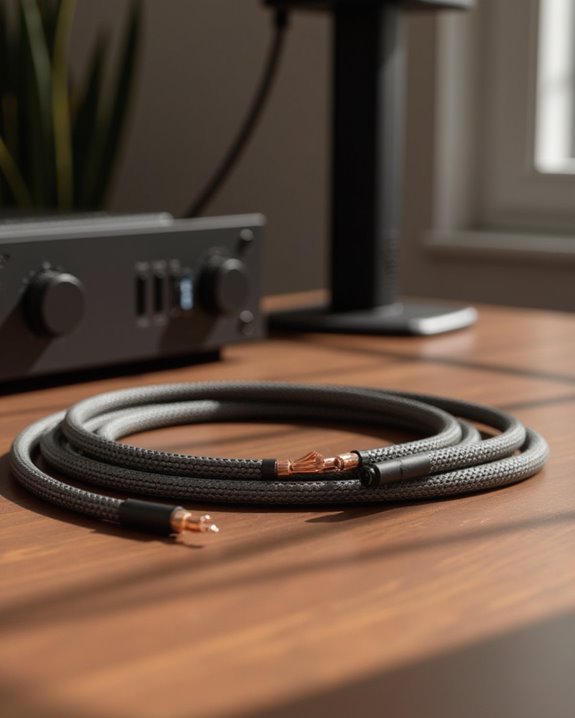
The relationship between speaker impedance and wire gauge selection represents a fundamental consideration that many audio enthusiasts overlook when assembling their sound systems. Lower impedance speakers (4 ohms) require thicker speaker wire, typically 12 AWG or even 10 AWG for distances exceeding 100 feet, to handle increased current flow and minimize signal loss. Conversely, 8-ohm speakers perform adequately with 16-18 AWG wire for runs of 50 feet or less, as they draw less current through the circuit.
For mid-range 6-ohm impedance systems, good speaker wire choices include 12-14 AWG oxygen-free copper wire when covering distances beyond 50 feet. The noticeable difference in audio quality becomes apparent particularly in lower impedance setups, where resistance management directly impacts power transfer efficiency and ultimately sound reproduction accuracy.
Selecting the appropriate wire gauge can enhance the performance of audiophile-grade woofers found in premium speakers, ensuring optimal sound clarity and bass response.
When to Use Thicker 12-10 AWG Cables for Home Audio

When selecting speaker cables for demanding audio installations, thicker 12-10 AWG options become essential in specific home audio scenarios where signal integrity cannot be compromised. For any home audio system with speaker runs exceeding 50 feet, these heavier gauge cables minimize resistance and prevent the signal loss that would otherwise degrade sound quality.
Choosing the right cable thickness becomes particularly critical when dealing with low-impedance speakers (4 ohms or less), where 12-10 AWG wire handles increased current requirements over longer distances up to 100 feet. Similarly, in-wall speaker installations benefit from thicker cables that maintain performance standards despite environmental constraints. Audiophiles will hear a difference when using appropriate gauge wiring for high-power amplifiers, as thicker conductors prevent voltage drops and overheating, ensuring ideal sound reproduction throughout the entire frequency range.
Budget-Friendly Options for Short-Run Speaker Setups
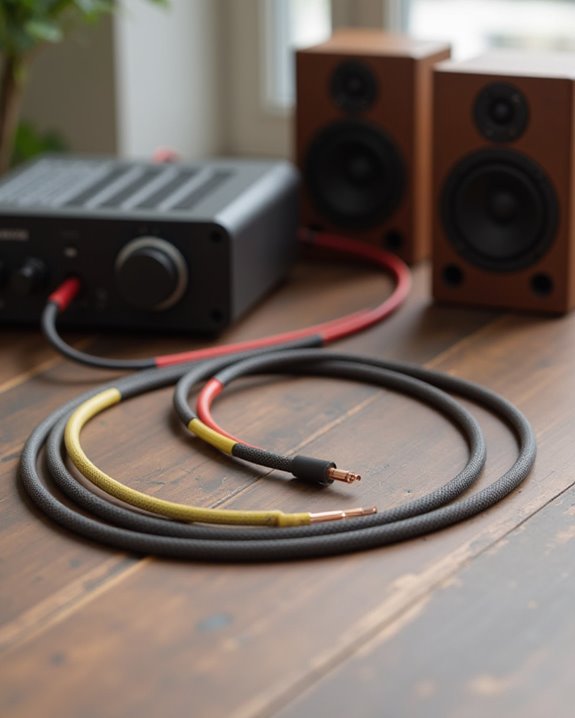
For budget-conscious audio enthusiasts, setting up short-run speaker systems presents an opportunity to achieve excellent sound quality without breaking the bank. When distances remain under 50 feet, 16-gauge wire offers the best choice for 8-ohm speakers, with options like Cmple’s 16AWG 2-conductor wire available for just $17.99 per 100-foot roll.
Consumers can choose the right termination method based on their setup needs, using either bare wires directly into speaker terminals or adding banana plugs for more secure connections. Crutchfield’s Banana Connectors, priced at only $3.99 per pair, work excellently with 16-gauge wire when connecting to binding posts. For additional savings, copper-clad aluminum wires perform similarly to pure copper in short runs while costing substantially less, making them ideal for budget home audio applications.
Furthermore, these budget cable options can enhance connectivity for Bluetooth 5.0 devices, ensuring stable performance in portable speaker setups.
Special Considerations for In-Wall and Outdoor Installations
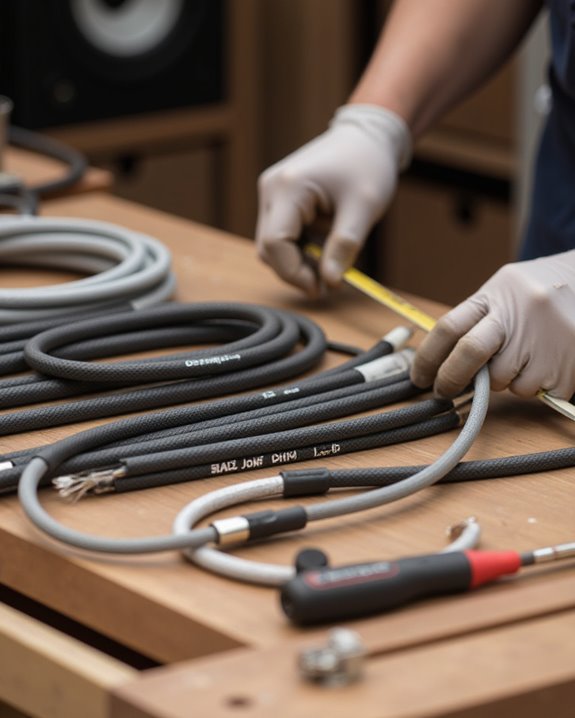
Installing speakers within walls or outdoors requires specific wire types that satisfy both performance and safety requirements, distinguishing these applications from standard, visible speaker setups. For in-wall installations, UL-rated CL2 or CL3 wire is mandatory to guarantee compliance with fire safety codes, as these cables limit smoke emission and resist combustion while accommodating various termination options including spring clips, spade connectors, and pin connectors.
Outdoor speaker wire must be rated for direct burial applications, featuring enhanced moisture resistance and UV protection to prevent degradation from environmental exposure. These specialized cables maintain signal integrity despite temperature fluctuations and moisture, guaranteeing reliable connections whether using banana plugs or other weather-resistant terminations. When selecting appropriate gauge for either application, installers should consider both the safety ratings and the specific environmental challenges the wire will face.
The Truth About Oxygen-Free Copper and Sound Quality
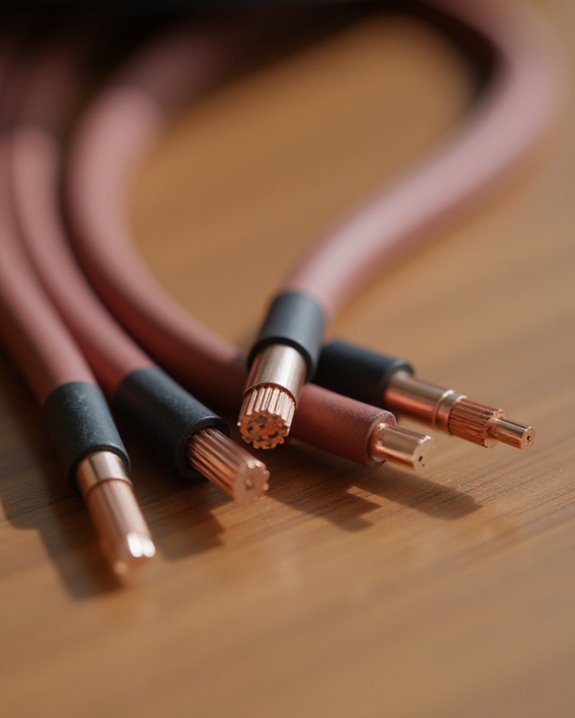
Why do oxygen-free copper cables command such premium prices in the audio market despite questionable performance benefits? Marketing claims suggest these cables conduct electricity better than standard copper, potentially improving analog audio signals in high-end audio systems. Manufacturers often justify prices up to $7,000 for a 12-foot cable by emphasizing reduced oxidation and enhanced signal integrity.
However, empirical evidence tells a different story. Audio experts and comparative tests consistently demonstrate no audible difference between oxygen-free and standard copper cables in typical home theater systems, particularly for wire runs under 8 feet. While oxygen-free copper may offer theoretical advantages in specific applications requiring long-term durability, the conductivity of standard 100% copper wire provides identical sound quality at a fraction of the cost for most home installations.
Proper Termination Methods for Different Gauge Wires
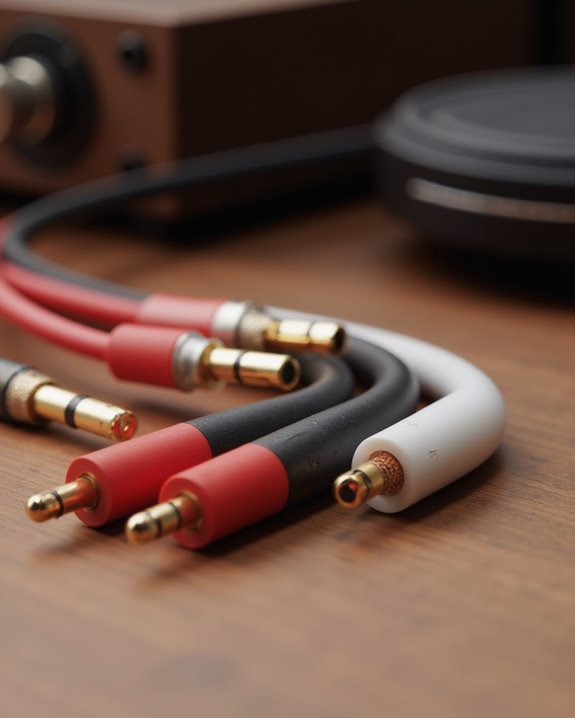
While audio enthusiasts debate the merits of oxygen-free copper, the actual termination method used with speaker cables often contributes more to system performance than the cable material itself. Professional audio installations require precise termination techniques, beginning with stripping exactly 3/8 inch of insulation from the wire without damaging the copper strands. When wire gets terminated properly, sound transmission improves measurably across all types of speaker setups.
Selecting the appropriate speaker termination depends on gauge thickness: banana plugs work well for 14-16 AWG connections when inserted with firm pressure, while thicker 12 AWG cables benefit from spade connectors. For car speakers and other spring-clip applications, pin connectors offer reliable connections with finer 18 AWG wire. In high-power applications reaching 2000 watts, specialized connectors like Speakon ends provide the most secure connection for 10 AWG cables.
Frequently Asked Questions
How to Choose Speaker Cable Gauge?
Like rivers of sound flowing through copper arteries, one selects cable gauge by considering Length Effects, Environmental Factors, impedance needs, and amplifier power. Thicker gauges overcome distance challenges, ensuring ideal Performance Benefits regardless of Material Types.
How Do I Choose the Right Gauge Wire?
Selecting appropriate wire gauge involves evaluating current capacity, distance requirements, and voltage rating. One should also consider wire material, insulation type, environmental factors where wires will be installed, and balance performance with budget considerations.
Should I Get 14 or 16 Gauge Speaker Wire?
Like traversing a musical maze, the 14 vs. 16 gauge decision depends on specific needs. Choose 14-gauge for longer runs, higher power, and better signal integrity. 16-gauge offers greater cable flexibility for shorter distances with minimal audio quality impact.
What Thickness of Speaker Cable Do I Need?
The needed speaker cable thickness depends on installation distance, speaker impedance, and power requirements. Thicker cables offer better power capacity and sound fidelity, while considering weather impact, setup simplicity, durability aspects, and cost implications when choosing.

